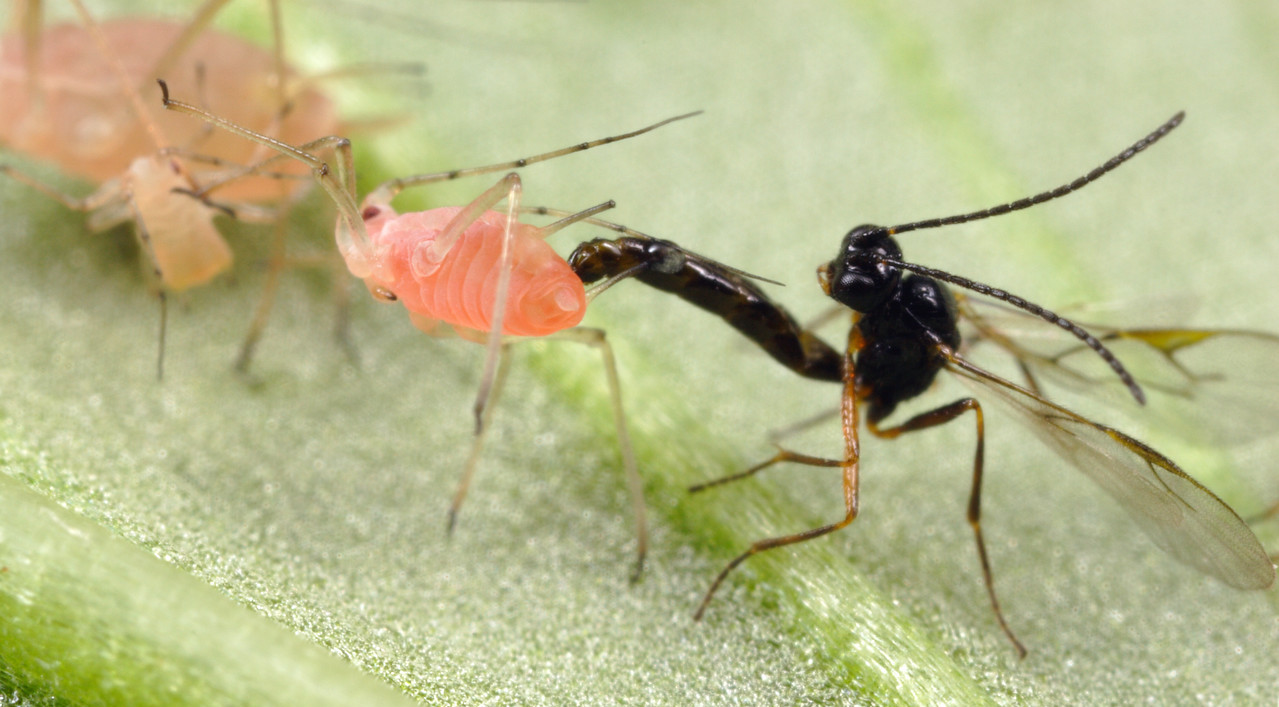When do spatial dynamics change outcomes of species interactions?

The effects of species interactions on communities often change with conditions in ways that remain unclear. Common plant epiphytic bacteria in the genus Pseudomonas can kill and repel pea aphids that transmit costly viruses among pea plants, which could provide local benefits to peas. However, repelling of aphids could lead to greater crowding and disproportionately more production of winged aphids on low-Pseudomonas plants. An increase in winged aphids should increase aphid-mediated virus transmission, resulting in negative effects on pea plants at larger spatial scales. Further complicating these interactions, plant viruses can often attract insect vectors, and by reducing aphid densities, aphid predators and parasitoids may modify how this symbiosis affects pea plants by reducing aphid crowding. We are using mathematical modeling to understand when the Pseudomonas–pea symbiosis is a net benefit versus cost for pea plants. Our results will provide a rare case study of how spatial scale and community interactions can together dictate the nature of multipartite and multitrophic interactions.
What maintains feedbacks between ecology and evolution?

Feedbacks between evolutionary and ecological processes that occur because they operate on similar timescales is called eco-evo dynamics. For eco-evo dynamics to persist, the variation underlying both processes must be maintained, yet this fundamental component of eco-evo dynamics has received little attention. Pea aphids can evolve resistance to parasitoid wasps rapidly enough to affect the host–parasitoid dynamics. Through long-term lab experiments and simulations, we showed that moderate aphid dispersal among fields combined with non-random parasitoid dispersal cause both species coexistence and balancing selection. These two forms of dispersal together resulted in stable, persistent eco-evo dynamics (Nell et al., Science).
How can feedbacks between dispersal and community composition affect regional coexistence?

Non-random dispersal can promote regional coexistence despite local priority effects and negligible immigration. In the many cases of animal-mediated dispersal, hitchhikers can coexist regionally when animal vectors respond to environmental cues. However, this possibility has been poorly understood, particularly when local priority effects lead to history-dependent exclusion. We used a mathematical model of competitive communities of nectar microbes in sticky monkeyflower (Diplacus aurantiacus) to study how feedbacks between microbial communities and pollinator-mediated dispersal affect coexistence. Analysis of this model suggests that regional coexistence occurs only when microbial communities influence pollinator visit frequency. This microbe–pollinator feedback creates positive density-dependence at the plant scale that results in spatial niche partitioning across multiple plants. This partitioning facilitates mutual invasibility and stable regional coexistence of microbes. Our results highlight the importance of interactions between dispersal and community composition across scales in shaping patterns of species coexistence (Nell et al. submitted; preprint).
How does population ecology shape genome evolution?

I am leveraging the extreme biology of chironomid midges (family Chironomidae, order Diptera) to understand how population ecology shapes genome evolution in natural populations. Chironomids are the most widely distributed group of freshwater insects and inhabit a vast range of habitats, many of which are inhospitable (e.g., Antarctica, hot springs). Yet we know little about the shared features underlying chironomids’ ability to tolerate extreme environments and how they achieve this despite especially compact genomes. In a recent paper, I described a number of candidate genes and gene families that may relate to chironomid tolerance to stress and show that their compact genomes are via reductions in repeat and non-coding elements (Nell et al. 2024, Genome Biology and Evolution). In a related project, I am using an example of extreme population dynamics to understand what happens to genetic diversity when populations experience frequent, short-duration bottlenecks. The population of Tanytarsus gracilentus at Lake Mývatn, Iceland, has irregular population fluctuations of about 5 orders of magnitude. In collaboration with Árni Einarsson (Director, Mývatn Research Station), I collected and sequenced T. gracilentus samples from Mývatn that spanned 24 years and 3 population crashes, and from 15 other lakes across northern Iceland. Our results so far are consistent with theoretical predictions about the effects of short-duration population crashes. Further analyses will provide greater insights into how the complex population dynamics present in many real populations shapes genome-wide patterns of genetic diversity.
Can trait coevolution among competitors promote coexistence?

Coevolution among competitors can result in traits that promote niche partitioning and coexistence or traits that promote greater conflict and competitive exclusion. We used an eco-evolutionary model where competitors “invest” in coexistence- and exclusion-promoting traits to assess when trait coevolution should promote coexistence or exclusion. We found that communities should often contain both types of traits, but exclusion-promoting traits should more strongly influence trait coevolution community-wide. We also found that, despite being more influential, species invested relatively more in exclusion-promoting traits should be most vulnerable to exclusion by a new invader. This may make communities containing multiple species with exclusion-promoting traits transitory (Nell et al. in revision; preprint).
